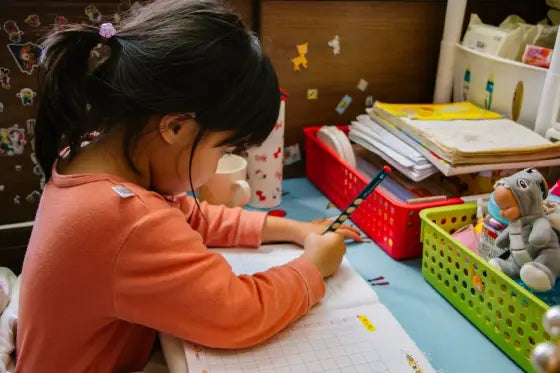Early Development of Language and Writing Skills
Early development of language and writing skills are essential to the long-term effectiveness and success of a child’s education. The developmental years of early childhood and middle childhood create the foundation for children’s reading and writing success. During these periods, cognitive functioning changes and skills such as vocabulary and reading ability grow at an accelerated rate. For this reason, it is important that children receive a proper curriculum and attention that is developmentally focused.
Early Childhood
The early childhood stage of development (2–6 years) is characterized by cognitive developments including increased communication and language skills. During this time, children will begin to talk more frequently and begin understanding more grammar and vocabulary (McDevitt & Ormrod, 2004). The stage of development is marked by ever-increasing learning ability. As children grasp more vocabulary and grammar this increases the ability to create cognitive connections and as a result, they learn faster than other age groups. For this reason, early childhood is crucial in the development and a proper curriculum must be administered in order to create the most effective patterns of thinking and learning.
The primary strategy for instilling proper reading and writing skills in children is to create a print or language-rich environment. Kindergarten and preschools should contain writing centers that serve the purpose of developing reading, writing, and motor skills such as eye-hand coordination. The writing centers should provide a wide range of reading and writing tools such as large pencils, crayons, paint brushes, finger paints, chalk, and other mediums for writing success. Tasks should be given that call upon the child’s ability to write such as painting letters or drawing animals and writing their names correctly. The use of different writing implements will also allow children to experiment and maintain interest in writing as well as increase eye-hand-coordination (Copple & Bredekamp, 2006).
As well as writing tools, there should also be a variety of reading tools. For this age group, there should be an ample supply of reading material that is developmentally focused. This means that the teaching plan should include a variety of materials and activities that focus on literacy skills that are developmentally appropriate (Copple & Bredekamp, 2006). The most fundamental and vital skills that must be developed during this time include:
· Knowledge of Letter Names- learning to identify and recognize them by sight and some sound.
· Phonemic Awareness- Learning different sounds of speech such as differences between letters to develop a basis for phonics word learning or sounding-out words.
· Print Awareness- Learning the way books work and mechanically for reading and writing.
There is a wide range of materials that can be used such as children’s books and flashcards. By developing these skills to their fullest, the child will be able to excel in the next stage of cognitive development.
Middle Childhood
Middle childhood development (6–10 years) is a period characterized by increased cognitive function focused on understanding logical and factual information. The largest area of development is in the increased ability of children to focus on a subject from multiple angles of thought. This means that the child is not able to begin developing different viewpoints of the subject matter. This change coincides with short-term memory enhancement.
This stage of development will be highly dependent on the level of vocabulary and writing skills that were acquired in early childhood development. This means that the more vocabulary and grammar skills the greater degree of understanding and perspective a child will have in middle childhood development. The primary strategy for the class curriculum is to continue developing reading and writing skills. To focus this strategy for the developmental period teachers should try to improve comprehension. Specific reading comprehension skills include reading material and trying to make predictions about the material before reading beyond the title or section heading (McDevitt & Ormrod, 2004). In this way, the child is focused on the outcome and this creates a deeper understanding of the material.
Another strategy is to have children discuss the material being read. Asking questions about the material also reinforces comprehension and this can also be used with writing skills by having children write down their thoughts concerning reading material (McDevitt & Ormrod, 2004). This act of discussing and writing about the material also serves the strategy of relating knowledge with the material to develop greater comprehension.
To develop writing skills, children should be asked to write down their thoughts concerning the predictions of reading material. For example, reading the title or chapter heading and then allowing the children to write predictions about the content creates a means of comprehension. This also serves to practice writing skills and grammar.
Summary
In order to facilitate the highest degree of learning and long-term educational success, it is vital that early childhood and middle childhood cognitive development be focused on the conditions of growth. The strategies employed during each period should work both with reading and writing but more importantly, they should enhance the developmental stage of growth. As children age, their thinking becomes more complex and the relation of knowledge to material becomes greater because they have more vocabulary and ideas to link (McDevitt & Ormrod, 2004). But by focusing interest in the material and creating activity around it will form the basis of all reading and writing strategies. The teacher should develop their teaching plans with this in mind for all developmental periods.
References
Copple, C. & S. Bredekamp, 2006. Basics of Developmentally Appropriate Practice. NAEYC, Washington DC.
McDevitt, T. M., & Ormrod, J. E. (2004). Child Development: Educating and Working with Children and Adolescents Second Edition. Upper Saddle River, New Jersey: Prentice Hall Pearson Education, Inc.
~Citation~
Triola Vincent. Fri, Jan 01, 2021. Reading & Writing Development in Early & Middle Childhood Retrieved from https://vincenttriola.com/blogs/ten-years-of-academic-writing/reading-writing-development-in-early-middle-childhood
